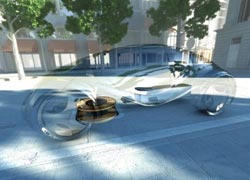Cable-free Charging of Electric Cars Via Coils

Developed in cooperation with BMW, this non-contact technology also works if drivers only make a short stop to recharge. The associated charging stations can be easily incorporated into practically any setting, making them nearly invisible and effectively protecting them against vandalism and wear and tear. In June 2011, the system’s capabilities will be tested in a project funded by the German Environment Ministry and involving several vehicles in Berlin.
A big obstacle to the expansion of electric mobility is the lack of an extensive and reliable charging infrastructure. Because electric cars have to recharge their batteries more often than vehicles with combustion engines need to refuel, various charging techniques are required that are adapted to the needs of the drivers and vehicles. Siemens’ inductive energy transmission concept would make it possible to automatically recharge vehicles such as taxis waiting at cab stands.
The charging station is connected to the public grid by a primary coil that is completely underground. A secondary coil is attached to the car, and the distance between the two coils is typically between eight and 15 centimeters. When the driver starts the charging process, an electric current begins to flow through the primary coil. The resulting magnetic field induces an electric current in the secondary coil, which recharges the battery. Electricity is transmitted from the grid through all of the components to the battery at an efficiency of more than 90 percent. The magnetic field is generated only in an exactly predetermined area between the two coils. The system therefore generates a magnetic field whose strength in and around the vehicle is far below the internationally recommended limit of 6.25 microteslas.
Starting in May, a prototype with a charging power of 3.6 kilowatts will be tested in an electric vehicle. Beginning in June, the test will be followed by trials in Berlin to determine which improvements are needed to integrate the system into series-produced vehicles under real-life conditions and to obtain customer feedback for future customer-oriented charging solutions. The system also enables the smart use of energy, whereby the car also serves as a storage unit and most of the energy is surplus electricity from solar and wind power facilities. At Hannover Messe, Siemens presented its complete range of electric mobility systems from the Energy (charging stations, smart grid technology) and Industry (electric motors) sectors.
Media Contact
More Information:
http://www.siemens.com/researchnewsAll latest news from the category: Power and Electrical Engineering
This topic covers issues related to energy generation, conversion, transportation and consumption and how the industry is addressing the challenge of energy efficiency in general.
innovations-report provides in-depth and informative reports and articles on subjects ranging from wind energy, fuel cell technology, solar energy, geothermal energy, petroleum, gas, nuclear engineering, alternative energy and energy efficiency to fusion, hydrogen and superconductor technologies.
Newest articles

Trotting robots reveal emergence of animal gait transitions
A four-legged robot trained with machine learning by EPFL researchers has learned to avoid falls by spontaneously switching between walking, trotting, and pronking – a milestone for roboticists as well…

Innovation promises to prevent power pole-top fires
Engineers in Australia have found a new way to make power-pole insulators resistant to fire and electrical sparking, promising to prevent dangerous pole-top fires and reduce blackouts. Pole-top fires pose…

Possible alternative to antibiotics produced by bacteria
Antibacterial substance from staphylococci discovered with new mechanism of action against natural competitors. Many bacteria produce substances to gain an advantage over competitors in their highly competitive natural environment. Researchers…





















